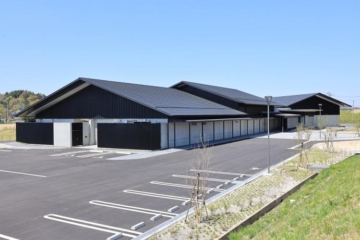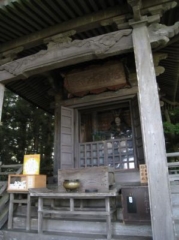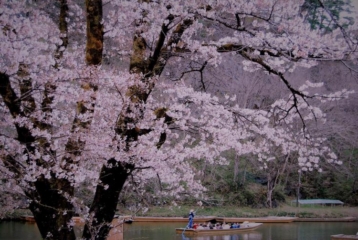MODEL COURSE
- Ichinoseki Station
- Iwate Prefectural Hiraizumi World Heritage Guidance Center
- Chusonji Temple [World Heritage Site]
- Takadate Gikeido
- Muryokoin Ruins [World Heritage Site]
- Motsuji Temple [World Heritage Site]
- Kanjizaio-in Temple Ruins [World Heritage Site]
- Ichinoseki hot spring village
- Geibikei Gorge
- Historical Park Esashi Fujiwara no Sato
- Mizusawa Esashi Station
Ichinoseki Station
15 minutes
Iwate Prefectural Hiraizumi World Heritage Guidance Center

On November 20, 2021, a facility opened that will serve as a base for disseminating information about the value of Hiraizumi's cultural heritage both domestically and internationally. There is a corner introducing the Yanaginogosho Ruins, which is said to be the site of the Oshu Fujiwara clan's government office.
Detailed Destination Information3 minutes
Chusonji Temple [World Heritage Site]
![Chusonji Temple [World Heritage Site]](https://iwatetabi.jp/wp/wp-content/uploads/2024/03/591-328x240.jpg)
Tendai sect, Tohoku Daihonzan. The name of the mountain is Kanzan, and Jikaku Daishi is the founder of the mountain.
At the beginning of the 12th century, the first Lord Kiyohira of the Oshu Fujiwara clan built many temples and pagodas, including the Tahoto and Nikai Daido.
Its purpose was to comfort the spirits of those who died in the long wars of the First Nine Years War and the Second Third Year War, and to build a Buddhist nation.
Unfortunately, the hall and pagoda were destroyed by fire in the 14th century, but it is still a treasure trove of Heian art, containing over 3,000 national treasures and important cultural properties, including the Kaneiroki Hall.
2 minutes
Takadate Gikeido

Takadachi is a hill located to the east of Chuson-ji Temple, and is also called Hangandate. Although it is now narrow due to erosion by the Kitakami River, this area has been considered a great strategic point since the Kiyohira era. At the top of Takadate is Yoshitsune Hall, which was built in 1683 by Sendai Date Tsunamura, and a statue of Yoshitsune is enshrined inside the hall. If you look at Takadate from the opposite bank of the Kitakami River, you will see Gikeido Hall on top of the hill surrounded by trees. It has an atmosphere as if Minamoto no Yoshitsune, the general of Hakko, is standing there.
Detailed Destination Information2 minutes
Muryokoin Ruins [World Heritage Site]
![Muryokoin Ruins [World Heritage Site]](https://iwatetabi.jp/wp/wp-content/uploads/2024/03/1679-309x240.jpg)
Muryoko-in Temple, built by the third generation Hidehira, is modeled after the Phoenix Hall at Uji Byodo-in Temple. Hidehira Temple was adjacent to the Garan Imperial Palace, where he lived. Most of the ruins have been turned into rice paddies, but the ruins of the pond, Nakajima, and temple foundation still remain. According to the results of the excavation survey conducted in 1955, it was a magnificent temple, with the axis of the temple running from east to west passing through the east gate, bridge, middle island, and bridge hall, and beyond which one could see Mt. Kinkeizan. It is known that
Detailed Destination Information2 minutes
Motsuji Temple [World Heritage Site]
![Motsuji Temple [World Heritage Site]](https://iwatetabi.jp/wp/wp-content/uploads/2024/03/2575-331x240.jpg)
Motsuji Temple, the special head temple of the Tendai sect, is called Iozan and was opened in 850 by Jikaku Daishi.
In the late Heian period, the Oshu Fujiwara clan's second and third generation, Motohira and Hidehira, built magnificent temples such as Kondo Enryuji and Kashoji, which numbered 40 halls and pagodas and 500 monks' quarters, making them the largest temple in Japan. It was called the second sacred place.
Unfortunately, the temple at that time was burnt down due to repeated disasters, but today the " Jodo Garden " centered around Oizumigaike Pond and the remains of the temple from the Heian period have been preserved in almost perfect condition, and the country has designated it as a special historic site. It has been designated as a scenic spot.
Kanjizaio-in Temple Ruins [World Heritage Site]
![Kanjizaio-in Temple Ruins [World Heritage Site]](https://iwatetabi.jp/wp/wp-content/uploads/2024/03/668-329x240.jpg)
It is said that the Kanjizaioin Temple ruins adjacent to the east of Motsuji Temple were run by the second wife of Motohira. The temple area is 120m from east to west and 240m from north to south. The square garden pond (Maizuru-ga-ike) with rounded corners is dotted with rock formations made of piled up megaliths similar to rough seashores, a small Suhama beach, and a long central island running east to west. On the north bank is a plaza, towards which are the remains of the Great Amida-do Hall to the west and the remains of the Small Amida-do Hall to the east. On the east bank, there are also the ruins of the bell tower and the ruins said to be Fugendo.
Detailed Destination Information13 minutes
Ichinoseki hot spring village

Ichinoseki Onsen Village has a variety of sizes and characteristics, ranging from hot springs that have been popular as hot springs since ancient times to hot springs that have sprung up in recent years. Surrounded by abundant hot water and rich nature, you can refresh your body and mind.
Detailed Destination InformationGeibikei Gorge

One of Japan's top 100 views.
It is an approximately 2 km long gorge created by the Satetsu River eroding limestone, with approximately 100 m cliffs rising on both banks.
The current is calm, and you can hear the boatman's song ``Geibi Oiwake'' as you go down the boat.
40 minutes
Historical Park Esashi Fujiwara no Sato

A vast historical theme park of approximately 20 hectares where you can follow the path of the Oshu Fujiwara clan and experience the history and culture of Michinoku.
Based on rigorous historical research, we have fully recreated the castle fences of ancient Tohoku, Toyota-kan, the residence of Fujiwara Kiyohira, the government offices of the Oshu Fujiwara clan, the Kara Imperial Palace, the residence of Hidehira, and the Golden Hall, the symbol of golden culture. .
It is also known as a filming location for numerous TV programs and movies, including taiga dramas.
We also hold regular performances of the local performing art "Esashi Deer Dance" (every Sunday from late April to mid-November). (Two performances a day 11:00, 14:00) Groups performing regularly in 2020
14 minutes
Mizusawa Esashi Station

![[Iwate Enjoyment Model Course] History Course](https://iwatetabi.jp/wp/wp-content/uploads/2024/03/03e4dcaf70dc946e96751e45c34ca7c3-960x640.jpg)
![[Taxi plan] Hachimantai/Matsukawa course](https://iwatetabi.jp/wp/wp-content/uploads/2024/03/3573-320x240.jpg)
![[Tekuteku Tour of Morioka] A walking trip through the castle town](https://iwatetabi.jp/wp/wp-content/uploads/2024/03/3415-360x240.jpg)